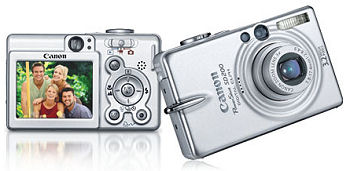
Powershot SD200 Review
|
Canon Powershot SD200 Review
Optical PerformanceGiven that this is an ultra-compact digicam operating with autoexposure, I'd rate the overall optical performance and image quality as good. Not perfect but good. For example, the image below is a full frame shot of the sky using the SD200 at it's widest zoom setting. The camera chose to shoot wide open, which is good from the point of view of testing for vignetting, since vignetting (dark corners) is worst when a lens is used wide open. It's also usually worst at wideangle settings.
As you can see, there's no really visible vignetting wide open at the widest zoom setting. A shot at the tele zoom setting didn't show any either! Below is a shot made at the tele setting (105mm equivalent focal length), together with 100% crops from the center and edge
As you can see, both center and edge are pretty sharp. There's little evidence of chromatic aberration or "purple fringing". Autoexposure of course, but it seems to have gotten it right! Below is a shot taken from the same position, but using the widest zoom setting (35mm equivalent). Again autoexposure has done a good job.
The 100% crops show pretty good center performance with a touch of softening towards the edges of the image, but still pretty decent performance. The shot below is a more severe test, with branches outlined against the sky right in the corner of the frame - which was again shot at the widest zoom position. Overall exposure is again pretty good.
In this image there is definite "purple fringing" in the corner of the image. This can be somewhat mitigated as shown in the rightmost crop, which was taken from the image after running it through the "chromatic aberration" correction in Paint Shop Pro 9. This is really a "purple fringing" correction and works by desaturating the image in the areas of purple fringing, but as you can see it does result in an improvement. So overall I think the SD200 does well. Vignetting isn't a problem, performance at the tele end of the zoom range is good, but there is some image softening at the corners at the widest setting. Purple fringing, though it can be induced, isn't too bad. In 4x6 prints none of these "defects" is going to be noticeable, though it may be if you make 8x10 prints. You can download some full size image samples from the SD200 page on the Canon website Operational SpeedThe SD200 feels fast and responsive. It takes under 1.5s from turning the camera on to taking the first shot. Shutter lag (after autofocus) is minimal, I'd estimate maybe 100mS (similar to an SLR). Even with autofocus, lag isn't objectionable and is routinely under 0.5s. In continuous exposure mode it easily meets the Canon spec of 2.4 fps. In single shot mode I fired off 10 shots in 7 seconds.FlashThere are multiple flash modes; flash on. flash off, autoflash, slow sync and redeye reduction. Flash performance is adequate. The flash is pretty small and doesn't have a lot of range, pretty typical for ultra-compact cameras. At the wide setting flash range is up to 11.5ft, at the telephoto setting it's up to 6.6ft. Coverage is good at the telephoto end, but at the wide end there's visible vignetting (dark corners) due to limited flash coverage.
The SD200 has a red-eye reduction mode, which is basically the autofocus assist light coming on and staying on until the flash fires. This tends to reduce pupil diameter in the eye and so lessen red-eye. However with a flash located only 1" from the optical axis of the camera, nothing is going to entirely eliminate red-eye. DistortionThere's visible distortion at the wide end of the zoom range, again pretty typical of small digicams. At the telephoto end of the range distortion is low, again pretty typical of small disgcams.
ConclusionsYou don't buy an SD200 (or SD300/400) for advanced photography. You can get cameras with more capability (aperture priority, shutter priority and manual exposure for example) for the same price or maybe less (e.g. Powershot A510 or Powershot A520, or check out my full review of the Powershot A610) However they are larger and the major reason you'd buy an SD200 is because it's small. Despite the lack of full manual control, I still like the SD200. In fact I bought one myself so I'd have a camera that I can basically take anywhere! Image quality is good and you do have manual control over almost everything except for exposure (and even there you do have exposure compensation). You also get some remarkably good video modes (with audio) including 640x480 at 30fps. The 3.2MP is enough for excellent 4x6 and 5x7 prints and even 8x10s can look OK (though if you're intending to print lots of 8x10s and your standards are high, you might be better off with a 5MP SD400). The price (currently around $180) is pretty good too! If you want more pixels, the SD300 has 4MP (around $250) and the SD400 has 5MP (around $265) in essentially the same camera body with the same camera features. If you do buy one, I'd strongly recommend getting the optional PSC-90 accessory case. It's designed specifically for the camera and has stiff sides which will protect the camera when it's carried in your pocket. © Copyright Bob Atkins All Rights Reserved www.bobatkins.com |
|






